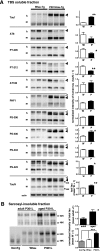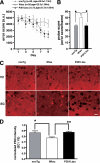Aggregation of detergent-insoluble tau is involved in neuronal loss but not in synaptic loss
- PMID: 20921222
- PMCID: PMC2992302
- DOI: 10.1074/jbc.M110.136630
Aggregation of detergent-insoluble tau is involved in neuronal loss but not in synaptic loss
Abstract
Neurofibrillary tangles (NFTs), which consist of highly phosphorylated tau, are hallmarks of neurodegenerative diseases including Alzheimer disease (AD). In neurodegenerative diseases, neuronal dysfunction due to neuronal loss and synaptic loss accompanies NFT formation, suggesting that a process associated with NFT formation may be involved in neuronal dysfunction. To clarify the relationship between the tau aggregation process and synapse and neuronal loss, we compared two lines of mice expressing human tau with or without an aggregation-prone P301L mutation. P301L tau transgenic (Tg) mice exhibited neuronal loss and produced sarcosyl-insoluble tau in old age but did not exhibit synaptic loss and memory impairment. By contrast, wild-type tau Tg mice neither exhibited neuronal loss nor produced sarcosyl-insoluble tau but did exhibit synaptic loss and memory impairment. Moreover, P301L tau was less phosphorylated than wild-type tau, suggesting that the tau phosphorylation state is involved in synaptic loss, whereas the tau aggregation state is involved in neuronal loss. Finally, increasing concentrations of insoluble tau aggregates leads to the formation of fibrillar tau, which causes NFTs to form.
Figures




Similar articles
-
Neurofibrillary tangle formation by introducing wild-type human tau into APP transgenic mice.Acta Neuropathol. 2014 May;127(5):685-98. doi: 10.1007/s00401-014-1259-1. Epub 2014 Feb 15. Acta Neuropathol. 2014. PMID: 24531886
-
Changes in dendritic complexity and spine morphology in transgenic mice expressing human wild-type tau.Brain Struct Funct. 2010 Mar;214(2-3):161-79. doi: 10.1007/s00429-010-0245-1. Epub 2010 Mar 7. Brain Struct Funct. 2010. PMID: 20213269 Free PMC article.
-
Tau protein is cross-linked by transglutaminase in P301L tau transgenic mice.J Neurosci. 2005 Feb 2;25(5):1226-33. doi: 10.1523/JNEUROSCI.3263-04.2005. J Neurosci. 2005. PMID: 15689560 Free PMC article.
-
[Significance of tau in the development of Alzheimer's disease].Brain Nerve. 2010 Jul;62(7):701-8. Brain Nerve. 2010. PMID: 20675874 Review. Japanese.
-
Regulatable transgenic mouse models of Alzheimer disease: onset, reversibility and spreading of Tau pathology.FEBS J. 2013 Sep;280(18):4371-81. doi: 10.1111/febs.12250. Epub 2013 Apr 22. FEBS J. 2013. PMID: 23517246 Review.
Cited by
-
A novel monoclonal antibody generated by immunization with granular tau oligomers binds to tau aggregates at 423-430 amino acid sequence.Sci Rep. 2024 Jul 26;14(1):16391. doi: 10.1038/s41598-024-65949-7. Sci Rep. 2024. PMID: 39060263 Free PMC article.
-
Neural atrophy produced by AAV tau injections into hippocampus and anterior cortex of middle-aged mice.Neurobiol Aging. 2023 Apr;124:39-50. doi: 10.1016/j.neurobiolaging.2022.06.014. Epub 2022 Dec 21. Neurobiol Aging. 2023. PMID: 36739619 Free PMC article.
-
Friend or foe: role of pathological tau in neuronal death.Mol Psychiatry. 2023 Jun;28(6):2215-2227. doi: 10.1038/s41380-023-02024-z. Epub 2023 Mar 14. Mol Psychiatry. 2023. PMID: 36918705 Review.
-
Mouse models of Alzheimer's disease.Brain Res Bull. 2012 May 1;88(1):3-12. doi: 10.1016/j.brainresbull.2011.11.017. Epub 2011 Nov 28. Brain Res Bull. 2012. PMID: 22142973 Free PMC article. Review.
-
HDAC6 mutations rescue human tau-induced microtubule defects in Drosophila.Proc Natl Acad Sci U S A. 2013 Mar 19;110(12):4604-9. doi: 10.1073/pnas.1207586110. Epub 2013 Mar 4. Proc Natl Acad Sci U S A. 2013. PMID: 23487739 Free PMC article.
References
-
- Gómez-Isla T., Hollister R., West H., Mui S., Growdon J. H., Petersen R. C., Parisi J. E., Hyman B. T. (1997) Ann. Neurol. 41, 17–24 - PubMed
-
- Ingelsson M., Fukumoto H., Newell K. L., Growdon J. H., Hedley-Whyte E. T., Frosch M. P., Albert M. S., Hyman B. T., Irizarry M. C. (2004) Neurology 62, 925–931 - PubMed
-
- Goedert M., Spillantini M. G. (2000) Biochim. Biophys. Acta 1502, 110–121 - PubMed
-
- Hutton M. (2000) Ann. N.Y. Acad. Sci. 920, 63–73 - PubMed
Publication types
MeSH terms
Substances
LinkOut - more resources
Full Text Sources
Other Literature Sources
Medical
Molecular Biology Databases
Miscellaneous

